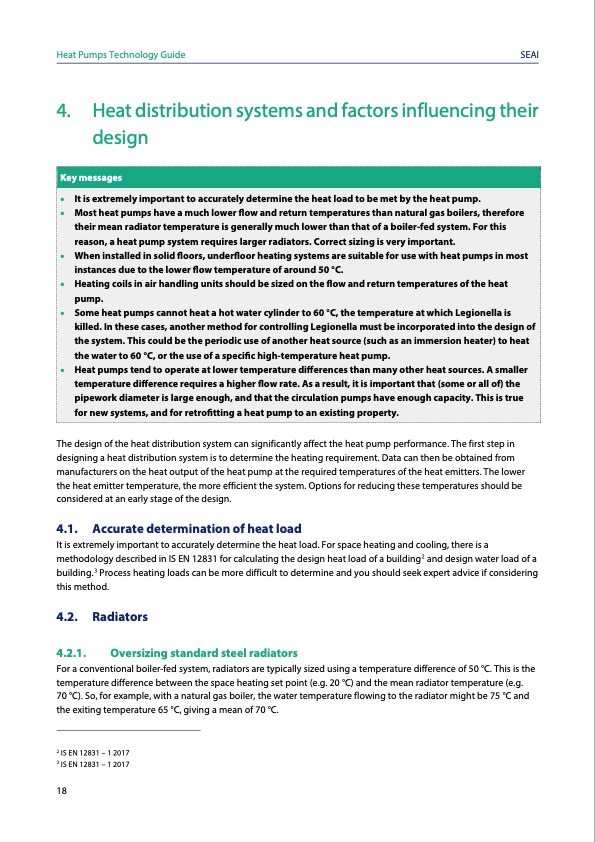
PDF Publication Title:
Text from PDF Page: 022
Heat Pumps Technology Guide SEAI 4. Heat distribution systems and factors influencing their design Key messages • It is extremely important to accurately determine the heat load to be met by the heat pump. • Most heat pumps have a much lower flow and return temperatures than natural gas boilers, therefore their mean radiator temperature is generally much lower than that of a boiler-fed system. For this reason, a heat pump system requires larger radiators. Correct sizing is very important. • When installed in solid floors, underfloor heating systems are suitable for use with heat pumps in most instances due to the lower flow temperature of around 50 °C. • Heating coils in air handling units should be sized on the flow and return temperatures of the heat pump. • Some heat pumps cannot heat a hot water cylinder to 60 °C, the temperature at which Legionella is killed. In these cases, another method for controlling Legionella must be incorporated into the design of the system. This could be the periodic use of another heat source (such as an immersion heater) to heat the water to 60 °C, or the use of a specific high-temperature heat pump. • Heat pumps tend to operate at lower temperature differences than many other heat sources. A smaller temperature difference requires a higher flow rate. As a result, it is important that (some or all of) the pipework diameter is large enough, and that the circulation pumps have enough capacity. This is true for new systems, and for retrofitting a heat pump to an existing property. The design of the heat distribution system can significantly affect the heat pump performance. The first step in designing a heat distribution system is to determine the heating requirement. Data can then be obtained from manufacturers on the heat output of the heat pump at the required temperatures of the heat emitters. The lower the heat emitter temperature, the more efficient the system. Options for reducing these temperatures should be considered at an early stage of the design. 4.1. Accurate determination of heat load It is extremely important to accurately determine the heat load. For space heating and cooling, there is a methodology described in IS EN 12831 for calculating the design heat load of a building2 and design water load of a building.3 Process heating loads can be more difficult to determine and you should seek expert advice if considering this method. 4.2. Radiators 4.2.1. Oversizing standard steel radiators For a conventional boiler-fed system, radiators are typically sized using a temperature difference of 50 °C. This is the temperature difference between the space heating set point (e.g. 20 °C) and the mean radiator temperature (e.g. 70 °C). So, for example, with a natural gas boiler, the water temperature flowing to the radiator might be 75 °C and the exiting temperature 65 °C, giving a mean of 70 °C. 2 ISEN12831–12017 3 ISEN12831–12017 18PDF Image | Heat Pumps Technology Guide

PDF Search Title:
Heat Pumps Technology GuideOriginal File Name Searched:
Heat-Pump-Technology-Guide.pdfDIY PDF Search: Google It | Yahoo | Bing
CO2 Organic Rankine Cycle Experimenter Platform The supercritical CO2 phase change system is both a heat pump and organic rankine cycle which can be used for those purposes and as a supercritical extractor for advanced subcritical and supercritical extraction technology. Uses include producing nanoparticles, precious metal CO2 extraction, lithium battery recycling, and other applications... More Info
Heat Pumps CO2 ORC Heat Pump System Platform More Info
| CONTACT TEL: 608-238-6001 Email: greg@infinityturbine.com | RSS | AMP |